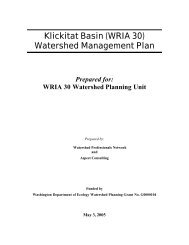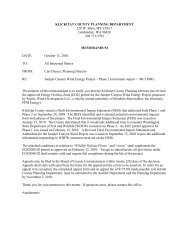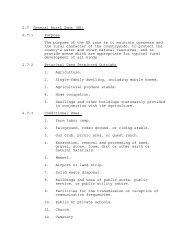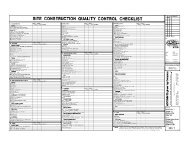WRIA 31 Instream Habitat Assessment
WRIA 31 Instream Habitat Assessment - Klickitat County Home
WRIA 31 Instream Habitat Assessment - Klickitat County Home
You also want an ePaper? Increase the reach of your titles
YUMPU automatically turns print PDFs into web optimized ePapers that Google loves.
4.3 BARRIERSField crews looked for potential barriers within the survey area and at all other locations that theypassed as they moved from one sample area to another. The following is a discussion regardingidentified barriers;Pine Creek Mouth: A group of 3 culverts are placed on the left bank (downstream orientation) ofPine Creek about 200 feet from the main channel. A 4th culvert is about 150 feet from the mainchannel on the right bank. These culverts pass under highway 14 and rail tracks near the mouthof Pine Creek. The culverts are not clogged; however, a large pile of alder (possibly a beaverdam) 100 ft upstream of the culverts seems to prevent water from flowing to the culverts. Theold streambed is overgrown, suggesting that flow has been diverted for a long time. The heightfrom the streambed to the culvert lip is 3.2 feet. This is likely a barrier to fish passage due to thelack of flow through the culvert. At extremely high flow/flood conditions, water may overflowthe beaver dam and pass through the culvert, allowing fish to pass. The culverts open directlyinto the Columbia River with no jump height. The right bank culvert has no stream bedupstream of culvert, indicating very infrequent flow through the culvert. A culvert which passesstream flow could potentially exist below the water level which was present at the time of thesurvey (12/7/08) and below the water level of the pond at the mouth of Pine Creek.A natural waterfall which blocks fish passage has previously been identified on Pine Creek. Thefalls is located roughly ½ to ¾ miles upstream of the lower East Road Bridge, which blocksupstream passage of fish (Jim Wright, personal communication, June 2004). The field crews didnot find this waterfall during the study. It is possible the location was reported incorrectly. Fieldcrews did document a waterfall in Reach 2 which was not passable at the time that data werecollected due to a lack of flow, but would be easily passable at higher flows.Wood Gulch: There is a series of waterfalls in Reach 3 of Wood Gulch (Figure 12). Each of the falls wasdetermined to be passable, but passage would be difficult in places.Figure 12. One of a set of four waterfalls located in Reach 3 of Wood Gulch.Old Lady Canyon: A reconnaissance survey was completed in lower Old Lady Canyon. Two“waterfalls” (vertical drops, no water) are present in the first reach of the basin. One is 17 feethigh and the second is 16 feet high. There is a 21 foot interval between the two drops where a<strong>WRIA</strong> <strong>31</strong> <strong>Instream</strong> <strong>Habitat</strong> <strong>Assessment</strong> 41 Watershed Professionals Network









